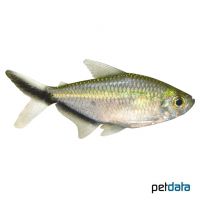Black Line Tail Tetra (Moenkhausia costae)
| Black Line Tail Tetra Moenkhausia costae | |
|---|---|
| Name | Black Line Tail Tetra |
| Name Lat. | Moenkhausia costae |
| Synonym | Tetragonopterus costae |
| Family | Characins |
| Family lat. | Characidae |
| Order | Characins |
| Order lat. | Characiformes |
| Origin | Brazil |
| Habitat | Forest streams |
| Diet | Omnivore |
| pH | 5.5-7.5 |
| Behavior | Peaceful |
| Keeping | Group |
| Care Level | Moderate |
| Reproduction | Egg scatterer |
| Breeding | Moderately difficult |
| Life Span | 2-4 years |
| Protection | No |
| Metric Units | |
| Size | 6-7 cm |
| Temperature | 23-28 °C |
| Hardness | 5-15 °dH |
| Aquarium | 100 l |
| US Units | |
| Size | 2.4"-2.8" |
| Temperature | 73-82 °F |
| Hardness | 89-267 ppm |
| Aquarium | 25 gal |
Distribution and habitat
Signal striped tetras are common in the Rio Sao Francisco and Rio Itapicuru river systems in northeastern Brazil. They live mainly in slow-flowing jungle streams with tree roots and branches wrestling into the water.
Maintenance
The aquarium should have a varied, partly dense planting, with shelters and hiding places (roots) and provide sufficient swimming space. A dark substrate covered with some foliage (e.g. sea almond leaves), shaded light (floating plants) and a weak current is ideal.
No ammonia, ammonium and nitrite should be detectable, the nitrate value should not exceed 100 mg/l. To ensure the water quality and oxygen content, a filter and heater adapted to the aquarium size is required, as well as lighting for the species-appropriate day-night rhythm of the animals.
Diet
The food supply consists of live food, such as daphnia, cyclops, artemia and mosquito larvae, which is also eaten in frozen form, supplemented with frozen food mixtures. Dry food, such as flake and granulated food is also well accepted. In addition, they occasionally require vegetable food, such as crushed peas, mashed leafy and wild vegetables, or dry food with high vegetable content (spirulina, kelp).
A regular and varied diet promotes health and increases resistance. Only feed as much as will be eaten within a few minutes.
Behaviour and compatibility
They are peaceful schooling fish that can be kept well in a community tank with barbs, danios, rasboras, etc. as well as with Corydoras. At least 5, but preferably much more signal tetras should be kept together.
Basically, only mutually compatible fish species with similar demands on water conditions and water temperature should be socialized.
Sex dimorphism
The slightly larger females appear rounder than the slimmer males, in which the signal stripe is more pronounced.
Reproduction and breeding
They usually spawn between fine-feathered plants (free spawners). The larvae hatch after 24-36 hours and swim freely from the 5th day.
Juveniles must be fed several times a day with special rearing food (dust food). Breeding is hardly possible in a community tank, as the spawn is easy prey here.
Important
They always swim in a group with the signal stripe providing cohesion
Feeding with plant food reduces the risk of the fish eating the tender shoots of aquatic plants. Kept in a group, other fish are rarely bothered and their occasionally quarrelsome behavior remains intraspecific.
The aquarium should be well covered as they like to jump.
The well-being of the fish should be checked regularly. Temperature should be checked daily, pH, hardness and nitrate levels at least every 14 days. Regular partial water changes are recommended, even if the contaminant level has not yet reached the upper limit. Sudden changes in water quality should be avoided. Newly introduced fish must be accustomed slowly to the water in the aquarium.
Further literature can be found in your pet store.
References
Text Werner Winter; Image: petdata
Source: BMELV (1998): Tierschutzgutachten - Haltung von Zierfischen (Süßwasser); ENGELMANN (2005): Zootierhaltung - Tiere in menschlicher Obhut: Fische, Verlag Harri Deutsch; BAENSCH & EVERS (2004): Aquarien Atlas Bd. 6, Mergus Verlag
- Gemäß § 21 Abs. 5 Tierschutzgesetz idgF
